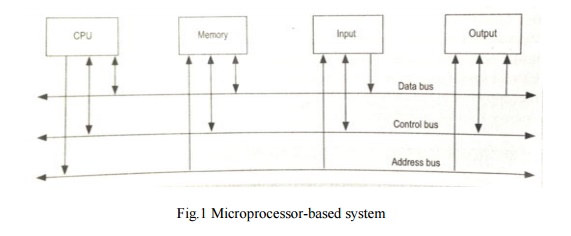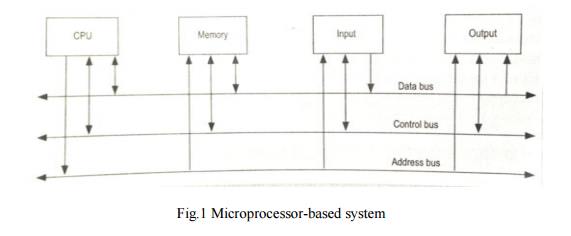Chapter: Microprocessor and Microcontroller
Introduction to Microprocessor and Microcomputer Architecture

INTRODUCTION TO MICROPROCESSOR AND MICROCOMPUTER ARCHITECTURE:
A microprocessor is a programmable electronics chip that has computing and decision making capabilities similar to central processing unit of a computer. Any microprocessor-based systems having limited number of resources are called microcomputers. Nowadays, microprocessor can be seen in almost all types of electronics devices like mobile phones, printers, washing machines etc. Microprocessors are also used in advanced applications like radars, satellites and flights. Due to the rapid advancements in electronic industry and large scale integration of devices results in a significant cost reduction and increase application of microprocessors and their derivatives.

· Bit: A bit is a single binary digit.
· Word: A word refers to the basic data size or bit size that can be processed by the arithmetic and logic unit of the processor. A 16-bit binary number is called a word in a 16-bit processor.
· Bus: A bus is a group of wires/lines that carry similar information.
· System Bus: The system bus is a group of wires/lines used for communication between the microprocessor and peripherals.
· Memory Word: The number of bits that can be stored in a register or memory element is called a memory word.
· Address Bus: It carries the address, which is a unique binary pattern used to identify
a memory location or an I/O port. For example, an eight bit address bus has eight lines and thus it can address 28 = 256 different locations. The locations in hexadecimal format can be written as 00H – FFH.
· Data Bus: The data bus is used to transfer data between memory and processor or between I/O device and processor. For example, an 8-bit processor will generally have an 8-bit data bus and a 16-bit processor will have 16-bit data bus.
· Control Bus: The control bus carry control signals, which consists of signals for selection of memory or I/O device from the given address, direction of data transfer and synchronization of data transfer in case of slow devices.
A typical microprocessor consists of arithmetic and logic unit (ALU) in association with control unit to process the instruction execution. Almost all the microprocessors are based on the principle of store-program concept. In store-program concept, programs or instructions are sequentially stored in the memory locations that are to be executed. To do any task using a microprocessor, it is to be programmed by the user. So the programmer must have idea about its internal resources, features and supported instructions. Each microprocessor has a set of instructions, a list which is provided by the microprocessor manufacturer. The instruction set of a microprocessor is provided in two forms: binary machine code and mnemonics.
Microprocessor communicates and operates in binary numbers 0 and 1. The set of instructions in the form of binary patterns is called a machine language and it is difficult for us to understand. Therefore, the binary patterns are given abbreviated names, called mnemonics, which forms the assembly language. The conversion of assembly-level language into binary machine-level language is done by using an application called assembler.
Technology Used:
The semiconductor manufacturing technologies used for chips are:
· Transistor-Transistor Logic (TTL)
· Emitter Coupled Logic (ECL)
· Complementary Metal-Oxide Semiconductor (CMOS)
Classification of Microprocessors:
Based on their specification, application and architecture microprocessors are classified.
Based on size of data bus:
· 4-bit microprocessor
· 8-bit microprocessor
· 16-bit microprocessor
· 32-bit microprocessor
Based on application:
· General-purpose microprocessor- used in general computer system and can be used by programmer for any application. Examples, 8085 to Intel Pentium.
· Microcontroller- microprocessor with built-in memory and ports and can be programmed for any generic control application. Example, 8051.
· Special-purpose processors- designed to handle special functions required for an application. Examples, digital signal processors and application-specific integrated circuit (ASIC) chips.
· Reduced Instruction Set Computer (RISC) processors
· Complex Instruction Set Computer (CISC) processors
Related Topics